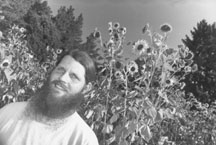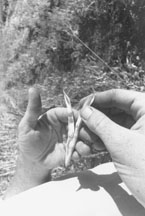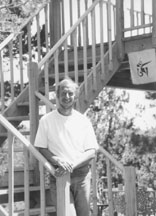
[ Menu Index | Metro Santa Cruz | SantaCruz Home | Archives ]
Seeding the Future
Sunflower Power: Santa Cruz organic farmer Mark Love grows his own legacy by cultivating seeds for Santa Febased Seeds of Change company.
Our global villages have become ominously uniform--the same handful of fast food giants, the same strip malls, the same glossy, Barbie-doll fruits and vegetables devoid of all flavor that fill our groceries. Well, make way for tomorrow, because here come the heirloom foods--again.
By Christina Waters
The most glamorous menus showcase heirloom produce. Farmers markets overflow with exotic shapes and colors. From the pages of small catalogs sprout seeds with names like Rainbow Inca corn, Appaloosa beans, Red Alpine fraises des bois, Zapotec pleated tomatoes. Nothing, it seems, is sexier than planting non-mainstream seeds, seeds that have eluded the Disneyfication of our everyday life and that offer an abundance of alternatives to one-brand-fits-all gardening.
Is it simply retro nostalgia that inclines more and more of the country's 60 million gardeners to, so to speak, try this at home? Is it something deep in our biological unconscious that gets a thrill out of planting a seed rediscovered after centuries of neglect, or of collecting seeds from some treasured flower, or a particularly tasty tomato, and saving it for another season?
Seed saving is all of the above, and more.
In the simple act of planting a seed, the gardener simultaneously blows a kiss to the past and guarantees the future. Preservation and proliferation are the twin agendas of the current heirloom/native seed movement. Preservation, in that the very way of life associated with old-fashioned flora is brought forward along with the flavors and fragrances that might have charmed our great-great-grandmothers. Proliferation, in that by continuing that legacy, and sending it speeding on toward our own grandchildren, we maintain the diversity of the world's herbs and plants--a diversity that also carries with it abundant phytochemical solutions to environmental, medical, even spiritual, diseases we've only begun to imagine.
The Irish potato famine of the 1840s perfectly illustrates the implications of a dwindling bio-gene pool. In a classic case of putting all its eggs in one basket, Ireland had planted its meager soil with a single variety of potato. Replicating a single set of genes, this was monocropping on a disastrous scale. When a virus came along to which these genes were susceptible, there were no alternative potato crops remaining to feed the country.
Your field of dreams is just a stamp or a page away.
Since all the potatoes were the same--homogenous, rather than biodiverse--they all succumbed to the plague. And, since the potato was the staple of the Irish diet, most of the Irish who couldn't emigrate starved to death. One biologist has likened this scenario to that of a thief, discovering that a single key can unlock every door in the mansion. And many feel that it's high time to change the locks.
Tending the earth's edible future reached its most poignant moment--certainly its most courageous--during the Nazis' World War II siege of Leningrad. The site of the world's largest seed bank--at which Russian botanist Nikolai Vavilov and his army of ethno-botanists had stockpiled an astonishing 200,000 species--Leningrad endured 900 days of attack during which over half a million people starved to death. Surrounded by harvested seed crops, the collectors martyred themselves rather than consume the botanical future. And when liberators finally entered the besieged facility, they found the emaciated bodies of the botanists lying next to full, untouched sacks of potatoes, corn and wheat--a priceless genetic legacy for which they paid with their lives.
The heightened consciousness about old-fashioned plant varieties blossomed along with the back-to-the-land movement of the '70s, and experts locate the exact moment in 1975 when Kent and Diane Whealy, armed with a legacy of antique Bavarian seeds from Diane's grandfather, began tracking down other "heirloom" varieties--ones that had been passed down from generation to generation.
The Whealys' personal quest evolved into Seed Savers Exchange, a network linking seed collectors and their odd pockets of cultural heritage all over the country. Today, this grassroots preservation movement maintains a living bank at its Heritage Farm in Decorah, Iowa--140 acres containing nearly 13,000 rare vegetables and an orchard of 700 old-time apples (a modest fraction of 7,000 apple varieties existing in this country at the turn of the century).
The Whealys' seeds have found their way into farms and gardens, like the Fetzer Vineyard Garden Project nurtured by Sonoma grower Jeff Dawson and into chef/entrepreneur Greg Holleman's Minnesota-based specialty foods company, Indian Harvest. While some groups have styled themselves as archives of biogenetic material--Jurassic Parks for vegetables--others have chosen a more commercial path.
Water from the Rio Grande irrigates the 30-acre Seeds of Change garden an hour north of Santa Fe, N.M. By dawn's early light, the land seems to levitate with fertility, its multi-textural patchwork of plantings glowing with rich greens, reds and yellows. Terraces of chamomile and basil work their way up toward the renovated ranch house where Seeds of Change Director of Agriculture Howard Shapiro and wife Nancy live. An allée of cottonwoods bears testimony to ranches long gone, shading aromatic beds of compost, whose sweet smell permeates the morning air.
Seeds of Change was founded in 1989 by a group of eco-visionaries--direct descendants of the home-grown, hippie movement. Run from its Santa Fe corporate headquarters, the company fills millions of seed packets each year with 100 percent certified organically grown, open-pollinated seed produced at 26 affiliated farms.
The original team included Gabriel Howearth, who studied with Alan Chadwick at UCSC's Farm & Garden before interning with Mayan Indians; filmmaker and grower Kenny Ausubel, whose passionate book Seeds of Change: The Living Treasure spread the biodiversity gospel; Bolivian Quechua Indian agronomist Emigdio Ballon; and molecular biologist Alan Kapuler, who today heads up the Seeds of Change research farm in Oregon.
Walking the gardens with intern Christian Petrovich, my senses are bombarded with the brilliance of orange Mars tomatoes weighing their stalks down to the ground. Scores of multi-colored native corns burst skyward in dense squares of open-pollinated yearning. Nearby, a graceful thicket of sorghum forms a living "room" within which chiles are sheltered from stray, unwanted pollen. Our boots quickly cake with mud from last night's rain as we circumnavigate clusters of 30 different chiles, miniature forests of onions, dense hedgerows of sweet clover, tomatillos and sweetpeas. Beehives punctuate the green, and a band of guinea fowl from a neighbor's ranch wander with gusto, lustily consuming grasshoppers as they roam.
"We plant all the rows two feet apart. That way, no soil is exposed, and it creates a living mulch. It's better for the soil," Petrovich explains, slapping at a mosquito. "But it's harder to work."
"These are really trial gardens," explains Shapiro, who joined the company as an investor four years ago, and assumed leadership when Ausubel left in January of 1995. The garden I'm looking at, however astonishing in its fecundity--with gigantic "teddy bear" sunflowers and lavish stands of pastel zinnia--is one of two research plots. Most of the actual seed-growing for the company takes place at far-flung organic gardens all over the country. One third of the total acreage is dedicated to composting crops--the perfecting of soil is never-ending
It was Ausubel's book and friendship with Gabe Howearth that changed the life of Santa Cruz grower Mark Love, who now raises herb and flower seed for Seeds of Change. Love also juggles a variety of farming-related jobs and sells produce to local restaurants like Gabriella Cafe and Pearl Alley Bistro to maintain self-sufficiency. On the land he rents in the Santa Cruz Mountains, the organic farmer spends a lot of time making sure the seeds he sends via UPS to Santa Fe are clean. "The processing is very laborious," he says, "because it all has to be done by hand."
Love doesn't begrudge the backbreaking work of organic farming and seed raising. "I figure there's no other legacy I'll be able to leave, so I wanted to pass on some purposeful heritage," he says. Without his work, and that of other organic seed savers, Love believes we'd be reduced to "just a few commercially sanctioned seeds."
Love, who cheerfully admits that his operation is so small that he's not even officially classifiable as a farmer, is committed to his livelihood. But, he explains, "It's incredibly hard work--I have a healthy respect for anyone doing agriculture." And he's proud of his relationship with the Santa Fe company. "I don't know how my life is going to touch the broad spectrum of food growing, but you have to motivate yourself to do what's important."
Stuart Dickson, an organic superstar who cultivates over three dozen varieties of heirloom tomatoes on 120 acres near Watsonville, is devoted to the explosive new market for heirlooms. "When the organic specialty market started up," Dickson recalls, "it looked like a great opportunity for me to be adventurous--to play with all these different colors and sizes and shapes." Learning about tomatoes during his days in farming the Capay Valley near Davis, he started incorporating their diverse shapes and hues into his planting.
The heirloom tomato business is so good that Dickson even confesses to "shipping them nationwide, 150 to 200 cases a day." He admits, though, "you sacrifice a lot of the flavor to ship them--I really recommend that people grow their own."
Seed Savers Exchange is Dickson's favorite source, and he recommends it to home gardeners everywhere. "It's so easy to do," he insists, "then they can begin to save their own heirloom seeds."
Seminal Figure:Kenny Ausubel, a founder of Santa Fe's Seeds of Change, continues to work for a sustainable future as an author, filmmaker and environmental strategist.
In the sunny Seeds of Change greenhouse, where seedlings begin their life and harvested seeds are carefully cleaned in front of cleverly configured fans, Emigdio Ballone runs his fingers through a trayful of salvia seed. "The big companies go for hybrids," he says, in a musical accent of the Andean highlands, "and that creates a dependency between certain plants and chemical fertilizers."
Admitting that the first thing he does in the fields each day is pray for the fruitfulness of the seeds, Ballone points out that each organism has its own place to live, a structure and internal behavior specific to a particular ecosystem. "Seeds are life--the future. When you work with seeds every day," his eyes gleam, "you have a different feeling, a different respect for plants."
"We view this all as large-scale gardening," says Howard Shapiro, looking out over crimson heads of amaranth spiraling flirtatiously toward a row of waist-high chard. "After all, we're planting them for their seed. That's why the garden looks the way it does." That's why it isn't row after identical row--with its delicate cosmos, fragrant sweet peas, sudden thrusts of Indian corn, overblown nicotiana, all loaded with genetic blueprints, selected for vitamins, flavor and a heady sense of vive la difference.
"Taste," Shapiro says of his company's purpose. We are on another tour, this time of the Seeds of Change shipping warehouse. "Taste and plant vigor--add to that nutritional value, and we do spectrographic analysis to make sure we give people the highest amount of amino acids, the best vitamin A and C."
Showing me the floor-to-ceiling inventory--in these bins, trays and bags is probably the world's largest collection of organic seeds--Shapiro points out that this is a commercial endeavor. "We are not a seed-saving company, though we are committed to supporting the work of groups like Seed Savers Exchange." Ironically, in order to ensure an inventory of organic, open-pollinated seed to fill their orders, Seeds of Change has had to decrease the number of varieties offered in its catalog.
The field work is ongoing, Shapiro notes, pointing to bags of thumb-sized blue corn kernels recently brought back from Bolivia. Believing that in the four years he's been on board, the company has gone from a "great idea" to a "real seed company," Shapiro is proudest of the fact that he delivers scrupulously clean seed. "And it has an enormously high germination rate, too," he adds, almost smiling under his flowing silver beard.
Future Think
A seed is not just a seed," says Kenny Ausubel, surrounded by the piñon pines and junipers of his land near Santa Fe. "It represents all the knowledge that went into it--how the people planted it, what songs they sang, what prayers they offered." Currently an eco-strategist for Odwalla juice company working with native American farmers on restorative agriculture, Ausubel recalls that the founding of Seeds of Change was a specific effort to link the preservation agenda with a business operation.
"We hoped that perhaps we could have a mission-driven company that would actually act as an economic force," he says. "If we don't create jobs around sustainable practices, we're not really going to have the impact we need to have." Ausubel says he recognized early on that a mere scattering of companies couldn't hope to save the world. "That's for sure," he grins wistfully.
"What is most important is the vision," he contends, looking out at the Sangre de Cristo Mountains looming in the horizon. "We're dealing with a lot of people who are simply not even aware that there is a problem, that we are losing genetic diversity. It's not that they're in denial--they don't even know."
It's taken the planet millions of years to slowly assemble and evolve its intricate cellular opera and there are still at least 50,000 known edible plants still left on earth. Yet only three of those--rice, corn and wheat--account for half of everything we eat. Ausubel, who left Seeds of Change a year and a half ago, after agreeing not to discuss the details of that dissolution, is convinced that kinship and diversity are the keys to all environmental models.
"Everything is related--from microbes to mammals, there's much more that's shared than is different," Ausubel contends. "When you remove the diversity, the system falters and starts to break down."
He loves to cite the example of the Idaho producer who grows for McDonald's corporation the exact same blight-prone russet that caused the Irish potato famine. "It's the McDonald's criterion of potato selection--a strain is bred and grown because it makes perfect four-inch French fries," Ausubel chuckles. "And that's the mentality that unfortunately is driving most of the world."
Why should people bother preserving and growing old seeds? "This is something people have done for a long, long time," says Ausubel, still passionate that individuals can make a difference.
"You realize when you look at one of these seeds that somebody, somewhere down the line, held onto this, even though it was really difficult--and they had faith," he says. "And by their simple act of faith and caring, they can change the world."
This page was designed and created by the Boulevards team.

Robert Scheer![[line]](/gifs/line.gif)
![[line]](/gifs/line.gif)

Bean There, Done That: Mark Love holds open an heirloom Hutterite dry bean pod, which, while commercially overlooked, powers the Santa Cruz grower's favorite minestrone recipe.
Going to Seed

Christina Waters
Back to the Garden
From the September 5-11, 1996 issue of Metro Santa Cruz
Copyright © 1996 Metro Publishing, Inc.